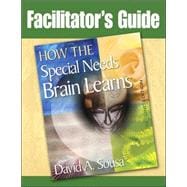
Note: Supplemental materials are not guaranteed with Rental or Used book purchases.
Purchase Benefits
What is included with this book?
| About the Author | p. vii |
| Introduction | p. ix |
| How to Use This Guide | p. ix |
| Additional Resources for Facilitators | p. ix |
| Chapter-by-Chapter Study Guide: How the Special Needs Brain Learns, Second Edition | p. 1 |
| Introduction | p. 1 |
| Summary | p. 1 |
| Discussion Questions | p. 2 |
| The Brain and Learning | p. 2 |
| Summary | p. 2 |
| Discussion Questions | p. 4 |
| Activity | p. 4 |
| Review of Brain Areas and Functions | p. 4 |
| When Learning Difficulties Arise | p. 4 |
| Summary | p. 4 |
| Supplemental Information | p. 6 |
| Discussion Questions | p. 7 |
| Activities | p. 7 |
| Guidelines for Working With Students Who Have Special Needs | p. 7 |
| Strategies for Involvement and Retention | p. 7 |
| Understanding the Strategies Integration Model (SIM) | p. 8 |
| Techniques for Building Self-Esteem | p. 9 |
| Attention Disorders | p. 9 |
| Summary | p. 9 |
| Supplemental Information | p. 10 |
| Discussion Questions | p. 11 |
| Activities | p. 11 |
| Avoiding Instructional Strategies That Lead to School-Created ADHD-Like Behavior | p. 11 |
| Strategies for working With Students With ADHD/ADD | p. 11 |
| Getting, Focusing, and Maintaining Attention | p. 12 |
| Speech Disabilities | p. 13 |
| Summary | p. 13 |
| Supplemental Information | p. 14 |
| Discussion Questions | p. 14 |
| Activity | p. 15 |
| Developing Oral Language Skills | p. 15 |
| Reading Disabilities | p. 15 |
| Summary | p. 15 |
| Supplemental Information | p. 16 |
| Discussion Questions | p. 17 |
| Activities | p. 17 |
| Strategies for Teaching Students With Reading Problems | p. 17 |
| Reading Bingo | p. 18 |
| Writing Disabilities | p. 19 |
| Summary | p. 19 |
| Supplemental Information | p. 21 |
| Discussion Questions | p. 21 |
| Activity | p. 21 |
| Identifying Students With Writing Difficulties | p. 21 |
| Mathematical Disabilities | p. 22 |
| Summary | p. 22 |
| Supplemental Information | p. 24 |
| Discussion Questions | p. 24 |
| Activity | p. 25 |
| General Guidelines for Teaching Mathematics | p. 25 |
| Emotional and Behavioral Disorders | p. 25 |
| Summary | p. 25 |
| Supplemental Information | p. 27 |
| Discussion Questions | p. 28 |
| Activity | p. 29 |
| Establishing a Positive Emotional Climate in the Classroom | p. 29 |
| Autism Spectrum Disorders | p. 30 |
| Summary | p. 30 |
| Supplemental Information | p. 32 |
| Discussion Questions | p. 32 |
| Activities | p. 32 |
| Interventions for Children and Adolescents With Autism Spectrum Disorders | p. 32 |
| True-False Questions About Autism Spectrum Disorder | p. 33 |
| Putting It All Together | p. 34 |
| Summary | p. 34 |
| Discussion Questions | p. 35 |
| Workshop Evaluation Form | p. 36 |
| Table of Contents provided by Ingram. All Rights Reserved. |
The New copy of this book will include any supplemental materials advertised. Please check the title of the book to determine if it should include any access cards, study guides, lab manuals, CDs, etc.
The Used, Rental and eBook copies of this book are not guaranteed to include any supplemental materials. Typically, only the book itself is included. This is true even if the title states it includes any access cards, study guides, lab manuals, CDs, etc.